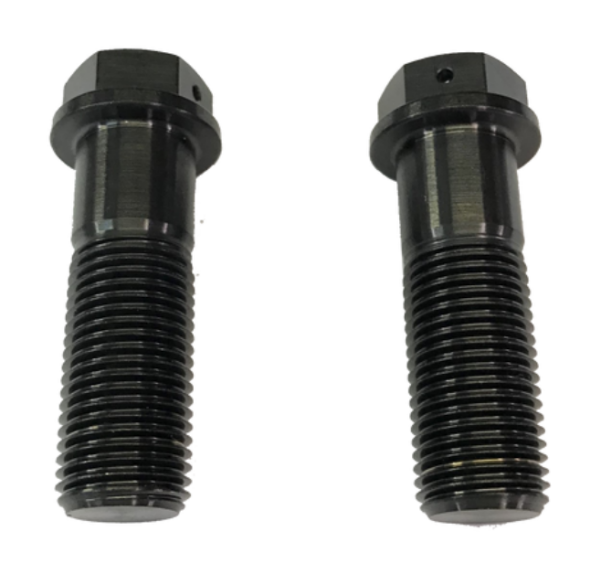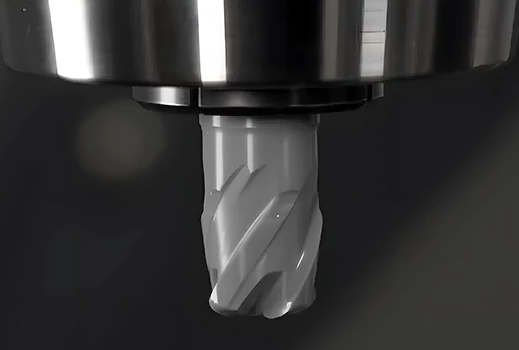Methods for Blackening Titanium: Anodizing, PVD & More
 Jul 10,2025
Jul 10,2025

Blackening titanium is the transformation of titanium product into a black and sleek masterpiece that's visually striking as well as highly durable. This process is called anodizing and is used in different industries from aerospace to medical devices. This article will explore all the essential information such as methods, pros and cons of each method and their applications. So, are you ready to dive into the field of blackening titanium and to know its potential? Let's get started!

What Is Black Titanium?
Black titanium is a titanium treatment to make it black in appearance through surface treatments like anodizing or coating. Titanium has a silver-gray color in its pure-natural form. That is why the change in color is not due to alloying composition but due to surface modifications.
Natural Oxide vs Engineered Coating
Natural titanium oxide is also called native oxide. It is normally grey due to thinness and its light interaction. This leads to interference and a limited absorption spectrum. While the Engineered coatings are thicker and have doped layers. It can appear deep black because of absorbing a broader range of light wavelengths, including visible light.
Natural Gray vs Engineered Black - Why Go Dark?
Natural gray occurs in materials naturally like stone or concrete. While engineered black are synthetic and are manufactured with composite material with pigment to achieve a black appearance.
Benefits of Engineered Black Titanium
Engineered black titanium is used widely due to its outstanding features.
- It has better solar energy absorption and absorbs a broader spectrum of light.
- It has better photocatalytic activity under visible light suitable for purification and pollutant degradation applications.
- It has higher charge carrier mobility and longer photoexcited electron lifetimes.
- It has enhanced optical and electronic properties.
Drawback of Engineered Black Titanium
However, there are few limitations of engineered black titanium.
- It has a potential toxicity.
- It can be challenging to produce large scale production.
- It has limited visible light photocatalytic activity.
- Higher costs than traditional white TiO2.
3 Proven Ways to Make Titanium Black
There are three the most common ways to black titanium: Anodizing, PVD/DLC and heat-based Patina which are discussed below in detail. Other than these, laser techniques are also becoming common which use like laser ablation, laser marking or a combination of laser texturing and anodizing. These methods offer a range of black surfaces finishes on titanium.
Method 1: Black Anodizing Titanium
There are 3 types of Black Anodizing: Type 1 (Chromic Acid Anodizing), Type 2 (Sulfuric Acid Anodizing) and Type 3 (Voltage-Controlled Color Anodizing). Type 2 is the most common one and involves dipping titanium workpiece in a sulfuric acid electrolyte solution and passing an electrical current through it. The current creates a chemical reaction, thickens the natural oxide on the surface and forms a porous structure.
Applications of Black Titanium Anodizing
Black surface treatments for titanium are used to increase corrosion resistance, heat management, or for aesthetic purposes.
Aerospace fasteners & brackets
Blacken titanium finish offers corrosion resistance, heat management and aesthetic on aerospace fasteners and brackets. It adds an extra layer to provide protection in harsh environments and for heat dissipation.
Consumer electronics
Blackening titanium improves visual appearance and sleekness in consumer electronics. It also has better corrosion protection for devices exposed to moisture or humidity.
Outdoor & tactical gear
Blackening titanium increases durability, wear and tear resistance in outdoor and tactical gear like bike components. It also has better corrosion resistance and is aesthetically pleasant.
Benefits of Black Titanium Anodizing
There are many benefits of black titanium anodizing
- It has higher corrosion resistance.
- Better wear resistance, abrasion and scratches resistance.
- Improves aesthetic appeal and ideal for consumer products and decorative applications.
- It has reduced Friction and Improved Tribological Properties.
- It has potential for Enhanced Heat Dissipation.
Method 2: PVD/DLC Black Coating on Titanium
PVD is Physical Vapor Deposition and DLC refers to Diamond-Like Carbon and are thin-film coating techniques used to improve the properties of titanium
What is PVD/DLC Black Coating on Titanium?
PVD is depositing a thin film onto a titanium by vaporizing it in a vacuum chamber and then condensing it onto the surface. DLC is a specific type of PVD which uses carbon as a coating material, diamond-like layer which is very hard and tough.
DLC coating is a specific type of PVD that uses carbon as the coating material, resulting in a very hard, diamond-like layer of black Titanium finish.
When to Use PVD/DLC Black Coating on Titanium?
PVD coating on titanium improves its durability, corrosion and wear resistance and its aesthetic appearance. DLC coating are known for their high hardness, low friction coefficient and high wear resistance.
Pros and cons of PVD/DLC Black Coating on Titanium
The advantages of PVD/DLC black Titanium finish are:
- It offers color variety other than black.
- It is cost effective.
- Offer high durability, hardness, corrosion resistance and wear resistance.
- It has aesthetic appeal.
The disadvantages of turning titanium black by PVD/DLC are:
- It has potential for fading
- It can have adhesion issues.
- Due to high hardness, it can be brittle or can crack and chip off.
Method 3: Heat-Based Patina & Laser Blackening
Heat-based patina on titanium is oxidation of surface by heating which changes in color due to different oxide layer thickness. Laser black method creates black layer by using laser and is better aesthetic or functional purposes.
What is Heat-Based Patina & Laser Blackening?
In heat-based patina, titanium is heated above the temperature of 600°C and creates a reaction with oxygen in the air to form a layer of titanium dioxide (TiO2). Laser blackening uses laser heat to create oxidation and to form a black oxide layer. Process parameters can vary depending on the applications of turning titanium black.
How To Patina Titanium?
The steps to Patina Titanium are:
- Clean the titanium.
- Heat the titanium.;
- Observe the color changes.
- Control the temperature.
- Quench or cool it down.
Pros & Cons
The advantages of heat-based patina titanium are:
- It offers a great customization of color.
- It has high durability of finish.
- It has aesthetic appeal.
The cons of heat-based patina titanium are:
- It has reduced strength.
- It has the potential of embrittlement.
- Consistency is difficult to control.
- Oxidation can create uneven color or rough surface.

Anodized vs PVD Black Titanium - Performance Showdown
Both anodized and PVD black titanium have different strengths and weaknesses which are as:
Wear & Scratch Resistance
PVD coatings have higher scratch resistance and hardness than anodizing. Anodizing also has good scratches and wear resistance, but it is prone to chipping and cracking with heavy abrasion. PVD is durable and tough and can withstand significant wear and tear.
Color Consistency & Re-workability
Anodizing offers a range of colors, but color consistency can be affected with titanium alloys. PVD offers a wide range of colors with color consistency and multiple finishes like matte, shiny or brushed. Anodizing also has more challenging reworking or repairing if damaged than PVD.
Cost per cm²
Anodizing is more cost-effective than PVD due to its simpler process. Indicative ranges are difficult to notify because they vary with the specific application. but in general, anodizing can range from $0.50 to $5.00/cm² and PVD has $1.00 to $15.00 or more per cm.
Design & Machining Rules for Black-Coated Titanium
Coating thickness during designing and machining parts for black-coated titanium is crucial to account for. There are a few things to keep in mind to avoid reworking after coating.
Leave Clearance for Coating
PVD Black coating on titanium parts adds layer that can affect dimensions. Therefore, during designing make slightly larger tolerance up to 2–4 µm or clearance to accommodate coating thickness. This will increase efficiency in assembling and in functionality.
Mask Threads & Sealing Faces
Areas where tight tolerances are required like threads or sealing faces must be carefully masked from silicone plugs or Kapton tape before the process. This prevents the coating building up and eventually will not affect the thread engagement, sealing performance, or overall part fitness.
Reset Torque After Coating
Surface friction is changed in blackening titanium coating which affects the torque required to achieve proper clamping and fastening. Therefore, torque values must be reset after the coating process. It is important to maintain the correct preload of fasteners and joints for their performance and safety.
Other Engineered Titanium Color Options and Uses
Engineered titanium can be colored in a range of colors and each color serves different purpose. The differences of titanium black color applications are:
|
Color |
Applications |
|
Blue |
Medical devices, and aerospace |
|
Yellow |
General applications, medical devices |
|
Magenta (Pink/Purple) |
General applications, medical devices |
|
Cyan (Teal) |
General applications, medical devices |
|
Green |
General applications, medical devices |
|
Bronze |
General applications, decorative purposes |
|
Black |
optical instruments |
TUOFA One-Stop Solution: From Titanium Machining to Surface Treatments
TUOFA offers a one-stop solution for your custom titanium parts. We offer both precision machining and a variety of surface finishing options based on your specific needs. The key features of TUOFA services are custom machining, material expertise, surface finishing, design analysis and quality control.
CNC Titanium Machining
TUOFA offers a wide range of machining services like:
Precision Turning (CNC Lathe)
High quality CNC lathe to remove material from workpieces.
5-Axis Titanium Milling
A CNC milling machine with five movement axes to machine titanium parts.
Thread Rolling & Tapping
Cold-forming process used to create threads on titanium cylindrical parts.
Wire EDM for Thin Walls
to cut intricate shapes from conductive materials using a wire electrode and electrical discharge.
Titanium Surface Finishing
TUOFA offers a wide range of titanium surface finishing services that include mechanical treatments, chemical treatments and coatings (PVD, CVD).
Conclusion
Black Titanium can be coated with various methods. The common ones are anodizing, and PVD (Physical Vapor Deposition. Anodizing forms a thin oxide layer that can be dyed black and PVD deposits a thin, durable black coating.
FAQ
What makes titanium turn black?
Titanium becomes black due to the formation of a darkened oxide layer or due to a roughened surface.
Is black titanium stronger than regular titanium?
No, blackening titanium does not change the strength of base titanium metal.
Does black titanium scratch or fade over time?
Yes, it can scratch, and the coating can wear off over time.
Which process is best for medical implants?
PVD is best for black surface treatments for titanium medical implants.
 Tel/WeChat:
Tel/WeChat:  Email:
Email: 
 Home
Home
 Aluminium Galling: Causes, Risks, and Proven Fixes
Aluminium Galling: Causes, Risks, and Proven Fixes 







